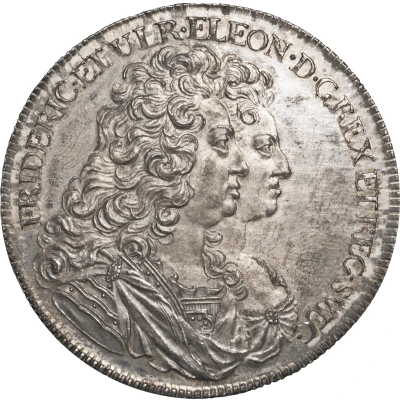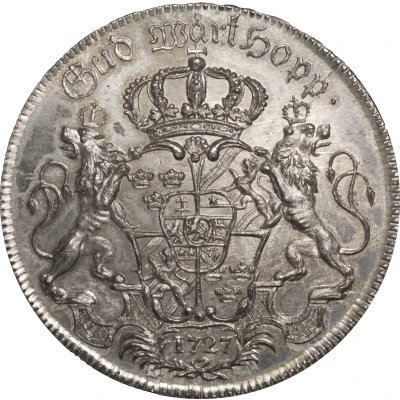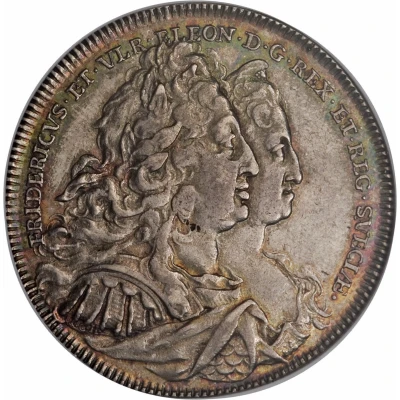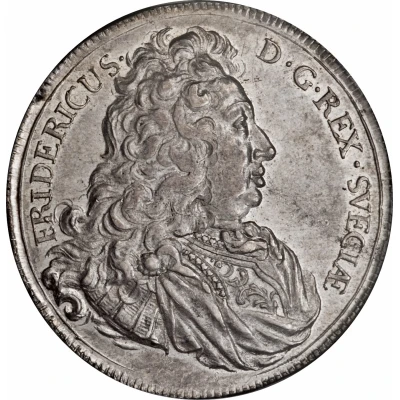
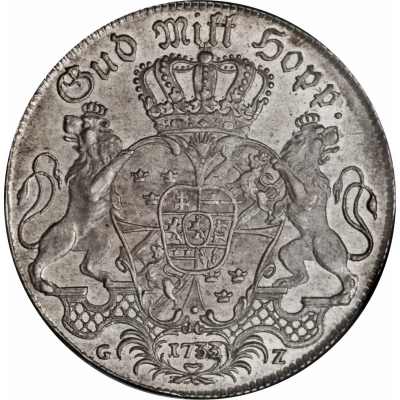

© Heritage Auctions
1 Riksdaler - Frederick I 2nd portrait
| Silver (.878) | 29.25 g | 41.45 mm |
| Issuer | Sweden |
|---|---|
| King | Frederick I (Friedrich I) (1720-1751) |
| Type | Standard circulation coin |
| Years | 1730-1733 |
| Value | 1 Riksdaler |
| Currency | Fourth riksdaler (1719-1798) |
| Composition | Silver (.878) |
| Weight | 29.25 g |
| Diameter | 41.45 mm |
| Shape | Round |
| Orientation | Medal alignment ↑↑ |
| Demonetized | Yes |
| Updated | 2024-10-07 |
| Numista | N#64692 |
|---|---|
| Rarity index | 95% |
Reverse
Crowned greater arms of Sweden in ornate shield held by lion supporters at sides. The date is below, in a cartouche made by palm crossed branches; mintark is at both sides of braches. Above the shield is the King's motto.
Lettering:
Gud Mitt Hopp .
1733
GZ
Translation: God is my hope.
Edge
Smooth with embossed lettering
Lettering: MANIBUS NE LAEDAR AVARIS
Comment
Even if Krause and Davenport divides riksdaler dated 1723 to 1728 (km# 395.1) from those dated 1730 to 1733 (km# 395.2) the more correct method to differentiate the various types of riksdaler is to look at the King's portrait.So Ahlstrom and other swedish catalogues distinguish portrait type 2 (with 3 subtypes) in riksdaler dated from 1723 to 1733 from portrait type 3 (with 2 subtypes) dated from 1731 to 1738. The main difference, besides the portrait style, is the presence of crowns on the drape that covers the armor. To combine both way I divided km# 395.2 in two: the first with portrait 2 the second with portrait 3.
Portrait type 2 has three sub-variant in portrait type:
TYPE 1723 and TYPE 1724 are both made by Johann Carl Hedlinger and are quite the same except for the ornaments on the chest of King's armor that are lightly different and the shulder ribbons that are more complex in 1724 type. More type 1723 has an edge ring clearly visible that is absent in type 1724
TYPE 1726 made by engraver Daniel Haesling. Different from Hedlinger's portraits. Again this type has the edge ring.
Interesting fact
One interesting fact about the 1 Riksdaler - Frederick I (2nd portrait) 1730-1733 coin from Sweden is that it was minted during a time of great economic change in the country. The coin was introduced as part of a new currency system implemented by King Frederick I in 1730, which aimed to stabilize the Swedish economy and simplify trade. The coin's design, featuring the king's portrait and the Swedish coat of arms, symbolized the country's commitment to economic growth and stability. Despite the challenges of the time, the coin remained in circulation for several decades and remains a valuable collector's item today.
Price
| Date | Mintage | VG | F | VF | XF | AU | UNC |
|---|---|---|---|---|---|---|---|
| 1730 GZ | 3992 | - | - | - | - | - | - |
| 1731 GZ | 18664 | - | - | - | - | - | - |
| 1732 GZ | 7442 | - | - | - | - | - | - |
| 1733 GZ | 11477 | - | - | - | - | - | - |
Values in the table are based on evaluations by sales realized on Internet platforms. They serve as an indication only for 1 Riksdaler - Frederick I (2nd portrait) 1730-1733 coin.
